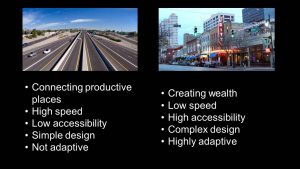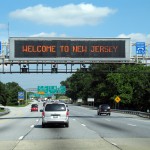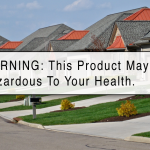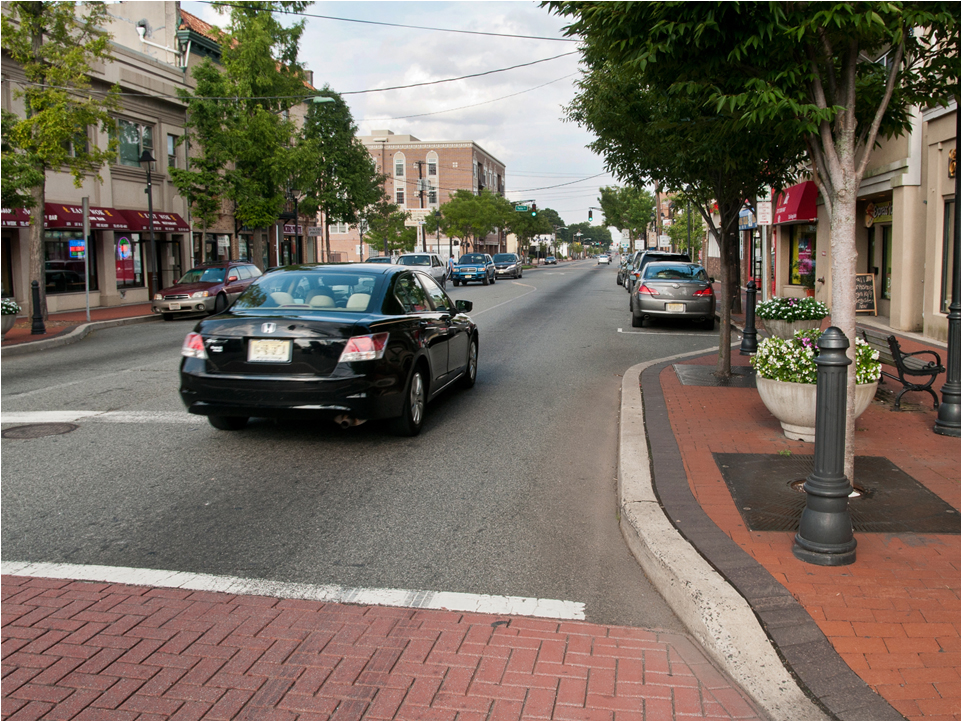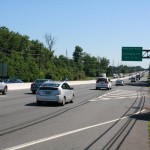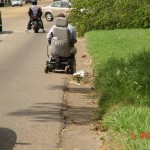New Jersey Future Blog
Chuck Marohn on the Value of Roads, Streets, and People
May 4th, 2016 by Tim Evans
“Pedestrians are the indicator species of success” for a downtown and its main street. This is how Chuck Marohn, founder of the nonprofit group Strong Towns, speaking at a recent event cosponsored by New Jersey Future and the North Jersey Public Policy Network, summed up why it’s counterproductive to treat a street like a road, and reminded his audience of the difference between the two. Roads are for connecting one place to another; streets are for creating value within a place, by serving as the organizing framework for the assortment of destinations that will attract people (and their disposable income). The more people you have, he argued, the more successful a place is.
Streets v. Roads
A road should have high speeds and low accessibility (i.e. a limited number of places to get on and off the road, so as to minimize the interruptions to the flow of through traffic). A road’s purpose is to move people and goods from one economically vibrant place to another as efficiently as possible. When a road experiences congestion, the solution is to add capacity.
A street, in contrast, should have low vehicular speeds (so as to ensure greater safety for pedestrians, the group that a street ultimately seeks to attract and retain) and high accessibility. A street’s purpose is to provide people (i.e. pedestrians, not cars) with access to a wide variety of destinations in close proximity. In other words, streets serve as the capillaries for high-density, mixed-use “centers.” They are about circulation within a place, rather than mobility from one place to another. The solution for a congested street is not to add vehicular capacity, but instead to shift cars to the periphery and give more space to pedestrians, however counterintuitive that may seem. If your place is already doing a good job of attracting members of the apex indicator species, the answer is to devote more space to them and less to the vehicles that bring them there.
Problems arise when transportation engineers try to apply road design principles to streets, awarding primacy to cars where it ought to be given to people; or when municipal zoning does the opposite, displacing in-town functions out to an outlying environment where cars ought to have priority. In the first case, a place can end up with over-engineered main streets that look more like highways, with too-wide lanes that encourage drivers to speed and that intimidate pedestrians. Vehicles move faster than they should, because the streets look too much like roads. (“If you need a sign to tell people to slow down, you designed your street wrong,” Marohn says.) In the second case, a place can end up with a “stroad” (Marohn’s coinage), a road that tries to provide high speed and high accessibility and fails at both. Here there will be destinations that ought to be located at the end-point of the road (i.e. in the center of town, the place to which the road is meant to connect) but which instead the municipality has decided to array along the road itself.
The resulting need to provide access to these inappropriately located destinations via traffic lights, driveways, curb cuts, and (with luck) turning lanes, along with the resulting constant disruptions caused by the acceleration and deceleration of vehicles using these access points, means that traffic winds up moving more slowly than it should, because the host municipality is trying to make the road function like a street. And these mutated main streets don’t serve pedestrians well, either; because the spacing of the destinations is a function of how fast vehicles, rather than pedestrians, can travel, these stroads all but ensure that people will have to get in their cars to move from one destination to another, even to adjacent stores. This too-wide spacing inhibits the creation of value that is the whole point of a street.
Streets Bring Pedestrians Bring Value
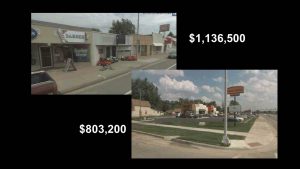
The taco joint on the right might be newer, but the “blighted” block on the left was more tax-productive. (Click for larger view.)
Another, often hidden, casualty of treating downtowns as if their primary customer is the automobile is the loss of productive tax base. One of the most eye-opening segments of Mr. Marohn’s presentation was a comparison of a new taco joint in his downtown – clearly car-oriented, with ample parking separating it from the street – to an adjacent city block of the same size containing a handful of small marginal businesses with entrances fronting directly on the sidewalk. The block occupied by the taco restaurant had previously contained similar businesses and had been deemed “blighted” by town leaders. But it turns out that, when viewed on a revenue-per-acre basis, the “blight” was actually more valuable. The taco restaurant generated more property tax dollars than any one of the marginal businesses individually, but thanks to its concessions to car access, it took up the entire block by itself. In contrast, because it did not have to make on-site space for cars, the adjacent block was able to host several businesses, none of which was individually more productive than the taco stand but which collectively generated more money for the town from the same total amount of space.
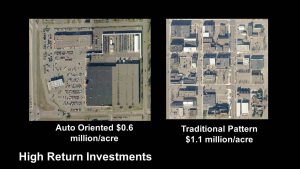
Traditional, pedestrian-oriented rather than auto-centric block design, produces higher tax revenue. (Click for larger view.)
Mr. Marohn’s hometown is not an isolated case; taxable-value parcel maps of other cities and towns in his presentation consistently showed the highest per-acre values occurring in those places with the highest density (the highest “intensity of uses”), even when those higher-density neighborhoods were more economically distressed. (A 2011 New Jersey Future intern case-study project – Financial Benefits of Density In Two New Jersey Downtowns – found similar results.)_Density more than compensates for distress, in terms of total property tax revenue generated.
Overall, the message of his presentation is that our system of planning and funding our transportation infrastructure is currently doing a pretty poor job of distinguishing between places where primacy should be given to cars and those where it should be given to people, with the car far too often prevailing. And by prioritizing cars over people everywhere, including in the center of town, we are sacrificing a significant amount of community wealth.
Video courtesy of the North Jersey Public Policy Network.

